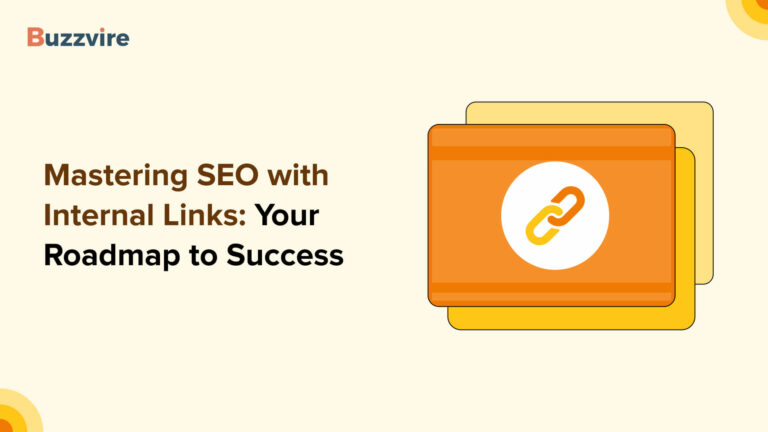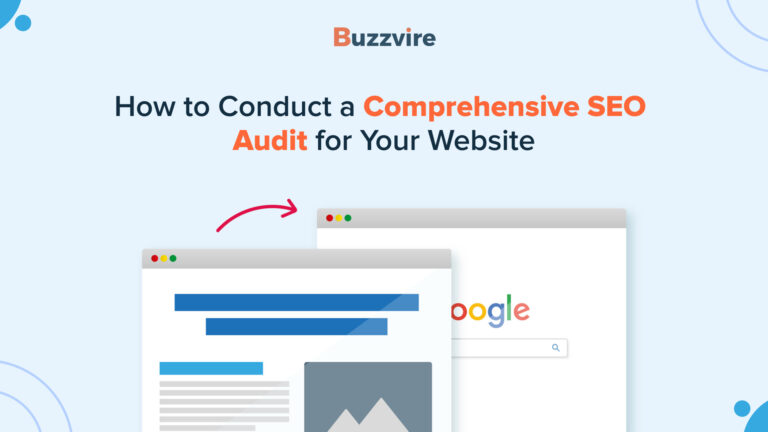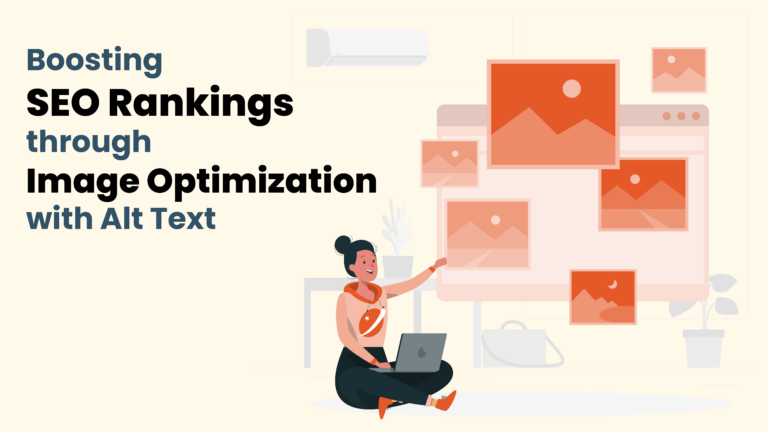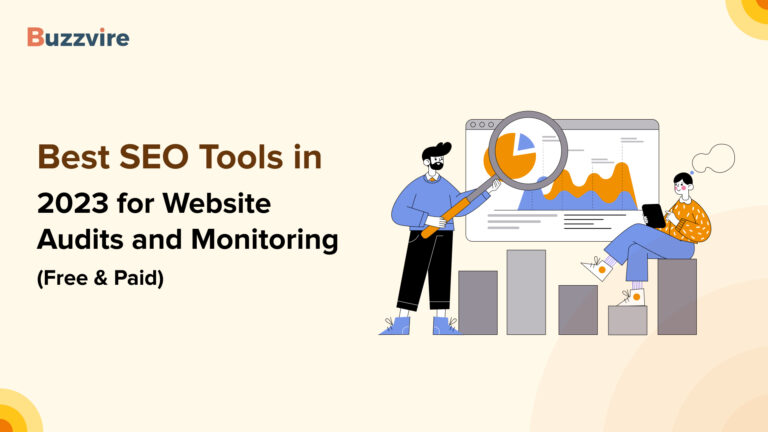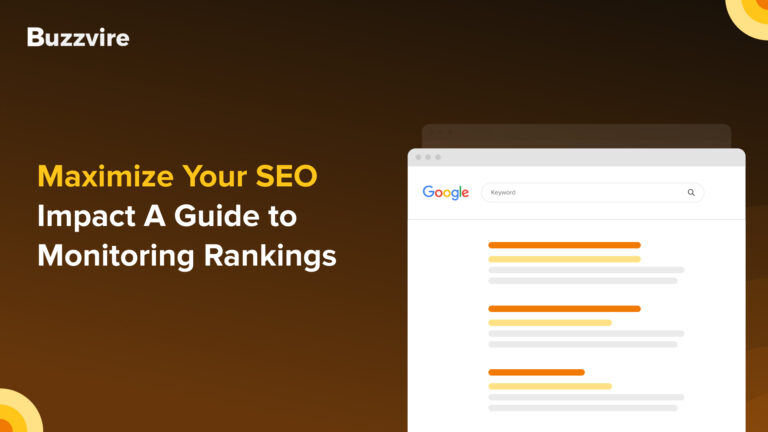Getting noticed online is an activity that has become imperative for businesses today; they simply can’t afford to ignore it. Say you run a small online boutique selling handmade jewelry.
As you run an online business, you must push to reach your products to a wider audience on the Internet. Making beautiful jewelry will only increase sales when people can access your website. You can email them your website links, but do you have their emails? How many can you send in a day? How many will open the emails and visit your link? This is a long process and needs to be more effective too. Working to optimize your website for SEO is a smarter and quicker method to reach the people already looking for businesses like yours.

As part of SEO optimization, you must conduct thorough keyword research, structure your website to its easier for both humans and search engines like Google, Bing, etc., to navigate, and add high-quality backlinks. This way, when people search for handmade jewelry in search engines, you stand a better chance to reach the relevant audience. The right SEO strategies and SEO implementation will help you get more valid traffic and generate more sales and revenue.
Defining Your Goals and Objectives
The first step towards SEO-optimization is to define what aspects you’d like to optimize. If you’re among those stuck wondering what the steps are to create an SEO strategy or optimizing your website for search engines, then the next sections are for you.
Importance of setting goals and objectives for a successful SEO strategy
Goals provide clarity and keep the direction in check. Once you set your priorities for SEO planning, you can manage your time and resources accordingly. Think of it as a roadmap that guides you toward your desired destination. Specific goals enable you to measure your success and track your progress over time.
How to use SMART criteria to define achievable goals and objectives?
SMART criteria mean goals must be Specific, Measurable, Attainable, Relevant, and Time-bound. Say you want your online boutique website to progress from SERP 3 to SERP 1 within six months. You can break down the entire effort into phases and milestones, keeping track of your constant progress.
Examples of common SEO goals and objectives and how they can benefit your website
By following a structured approach and implementing proven strategies, you can maximize the impact of your SEO efforts and achieve your online goals.
Here are the steps to developing an effective SEO plan and common SEO goals.
- Improve Search Engine Rankings: Appear higher up in the searches to gain better visibility in search engines. People find it more convenient to browse the initial SERPs(Search Engines Result Pages). By improving search engine rankings as one of your SEO goals, you stand a better chance of reaching your ideal audience.
- Increase Conversions: Better SEO results help reach the precise audience per your intended demographics. Relevant content reaching the right audience results in better conversions.
- Build High-Quality Backlinks: Drive more traffic from valid and trustable websites for a win-win for all parties. High-quality backlinks come from your website’s credibility and authority in a niche.
- Increase Organic Traffic: Optimizing your site for SEO attracts more search users organically. With more user visits, search engines understand your website is trustworthy and resulting in expanding to a more extensive section of searchers.
- Enhance User Experience: If your website is easy for search engines to crawl, it’s easier for visitors to browse too. When you create a comfortable user experience, your visitors will stay longer. You can achieve this through a faster-loading site, ease of navigation, and ease of use.
- Optimizing for local SEO: Set goals to have your website appear in more local searches. You can add customer reviews, make online and offline business listings, and add more relevant local content to your website. Local SEO optimization helps to increase web traffic and also helps to drive walk-ins to your offline store.
Conducting a complete website audit
A website audit allows discovering the imperfections in your website. It’s like a checklist for you to get started in optimizing your website. Always conduct an audit, so avoid reworking after starting.
Why should we conduct a full website audit before chalking an SEO strategy?
A comprehensive website audit is similar to a health check-up before a surgical procedure. It helps to identify and work on any issues before the actual major procedure. The audit tells you if there are some problems because of which search engines won’t rank your pages.
Some of the things as part of the audit include checking for dead or broken links, irrelevant or duplicate content, mobile-friendliness, slow-loading pages, and so on. Fix these and related issues to get the site in good condition to have search engines crawl your website and pages.
The audit must also include various parts of the website, including the content quality, format of presentation, and how relevant the content is. The content matching the search intent of the user shows up in SERPs. The content audit must also look at titles, subtitles, and the flow of the content.
A few other reasons to perform a website audit are:
Backlinks: Part of the website audit is the backlink profile to your website. It tells you if those links bring you relevant traffic or not. This is an opportunity to filter out the poor or bad backlinks affecting your website’s SEO.
You can use SEMRush SEO tool for the backlink analysis & Identify Irrelevant, Toxic & expired domains backlinks.

Measure performance: Check the effectiveness of your website regarding online engagements or sales. If there are technical difficulties for customers to complete transactions, search engines avoid recommending your site in the SERPs.
Study competitors: Look at what your competitors are doing differently or even if they are copying you. Competitor SEO analysis will tell you what is getting them the traffic and see how you match against that. This information can give you ideas on making your website stand out and beat your competitors.

A step-by-step guide to conducting a thorough website audit to identify areas for improvement
Analyzing your SEO performance for better results is a step toward achieving your SEO goals. Here’s a step-by-step guide to conducting a thorough website audit and SEO implementation:
- Crawl the website to identify technical issues.
- Review on-page elements like meta tags and headings.
- Assess site speed and mobile responsiveness.
- Analyze content quality and relevance.
- Check for indexing issues and verify the sitemap.
- Examine the backlink profile for quality and relevance.
- Monitor analytics and metrics for performance insights.
- Create an action plan based on audit findings.
- Regularly monitor and update your website.
- Make adjustments to your SEO strategy as needed.
Identifying Your Target Audience and Keywords
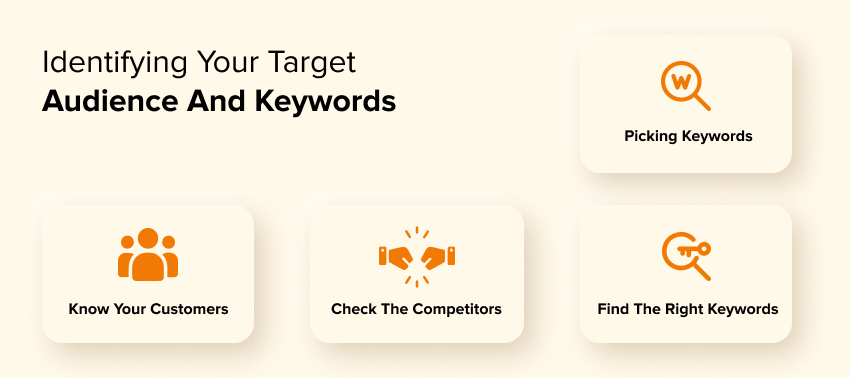
Start by looking at your data to have an idea to start. Data will give you clues about your keywords, phrases, and target audience. If you’ve subscribed or incorporated analytics, you can check the demographics to understand their preferences.
Know your customers: Who would most like to buy your products or try your service? This means the age range, location, preferences, and other interests.
Check the competitors: It doesn’t hurt to see what your rivals are doing and which audience their content targets. Their customers may be your customers too.
Find the right keywords: Imagine you are a customer of your product, and what would be your search queries to find relevant businesses online? These become your keywords to target via your content.
Picking keywords: Keywords are the gateway to your website. Pick the relevant keywords that’ll get you traffic. Look for keywords outside the most popular list. Slowly ranking for the easier can eventually get your traffic from the popular keywords.
Why understanding your target audience is the foundation of a successful SEO strategy?
The audience is the foundation for all SEO efforts. Everything revolves around your audience. Knowing your audience helps you better prepare your content strategy. This helps to present content and target the right keywords. Sending the right message starts with knowing the intention of the message.
How to identify your target audience and conduct effective keyword research?
Identifying your target audience requires careful planning. Say you have a cruise ship that you want to fill with interested passengers. So you’ll need to know what strategies your competitors are using. You’ll need to know the keywords your customers use for searching for cruises. You’d want to create advertisements about the benefits they’ll get if you book your cruise.
Your target audience may be from different segments like couples, large family groups, or leisure-seekers with the kind of budget you’d expect. This knowledge gives you a better understanding of preparing your messaging in your content and keyword research.
Examples of effective keyword research tactics and how to use them to your advantage
Think of keyword research as an interlocking puzzle. Scattered puzzle pieces are your keywords. Put them together to complete the puzzle and find the right audience. Examining the right piece that’ll fit next to its destined position applies to the keyword research tactics as well.
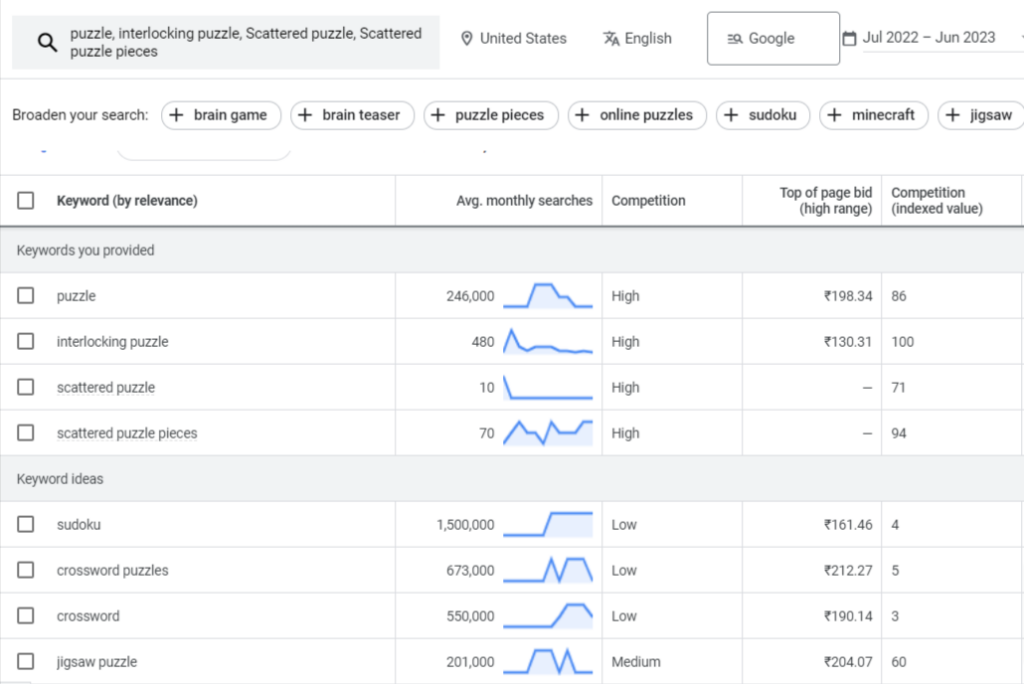
Finding the apt keywords to reach your target audience may require trial and error. Using valuable insights and patterns, you can take hints for the content strategy to improve your website’s visibility in SERPs.
You can use free and paid tools like Google Keyword Planner, Ahrefs, and Semush to discover valuable insights. They show you how popular the keywords are and how much competition each has to rank higher. Once you have the keywords, use them to create high-quality content around the user’s requirements and possible needs.
How can you develop a content strategy?
A content strategy derives from your business goals, services, and keywords analysis. Create valuable, unique, and engaging content to attract customers to the site and turn them into loyal fans.
How can having a content strategy drive traffic and boost your website’s visibility in search results?
Establishing yourself as an authority requires consistent and deep-researched content publishing on your website and social channels. Valuable and targeted content resonates well with your audience if it helps solve their problem or improve their knowledge. The key to driving relevant traffic is a well-designed content strategy. It will boost your content creation efforts, improve branding, and improve search results.
Step-by-step guide to developing a content strategy that aligns with your SEO goals

Ensure your content strategy aligns with the SEO goals you set at the start of the process. Here is a step-by-step approach to creating an effective content strategy:
Know what you want: Note the objectives of your content strategy. Is it to boost user engagement, increase organic traffic or improve search engine rankings? Identifying your objectives will help shape your content strategy and provide a clear direction for your efforts.
Use keywords to find your audience: Keywords research requires extensive effort. It is like the bait you’d use for fishing. Keywords help your customers come to you via search engines. Use keyword research tools to identify appropriate keywords with high searches and medium competition—the keywords from your research help in getting closer to your target audience.
All about your audience: Get to know everything about your customer – the times they are most active, their likes and dislikes, their current problems, and their desire. Knowing every small detail about your audience helps you better craft content that’ll resonate with them.
Content calendar: With a well-defined content calendar, you can set milestones for your progress. A well-defined calendar lets you track your progress and schedule ad-hoc events.
Relevant and resonating content: Use images as part of your content pages to relate with the audience. Relevant content aligns with your SEO goals, and use the keywords in your research.
Optimize on-page elements: On-page is an important part of SEO that includes meta descriptions, headings, URL structures, and title tags. You can improve search engine visibility with strategic-placed keywords in different on-page elements.

Promote, promote, promote: Just creating content isn’t enough. Your content must reach far and wide to attract customers to your website. Develop a comprehensive promotion strategy to increase the visibility and reach of your content. Utilize social media platforms, email marketing, influencer outreach, and other promotional channels to drive traffic and engagement to your content.
Close monitoring and adapting to change: Things don’t always go according to plan. So keep monitoring metrics and be ready to alter the plan if needed. You can use tools to measure page views, engagement, conversions, and organic traffic. These indicators share the content strategy effectiveness.
Tips for creating high-quality, SEO-friendly content that engages your audience
Use these tips to create resonating and engaging SEO content for your target audience.
- Find the most popular keywords for your topic
- Create unique and engaging headlines
- Use headings to your advantage
- Avoid keyword stuffing; space them out in your content
- Target your audience’s pain areas
- Include visuals like images and videos to make your content engaging
- Content must be easier to read with a lot of breaks
- Update older content regularly with relevant data and facts to keep it fresh
- Share your content on social media and other platforms to reach more people
Why do you need to Optimize Your Website?
An SEO-optimized website performs well in search results and makes it more attractive to visitors. Read on for more reasons why you must regularly optimize your website.
- Fast-loading websites are attractive to not just visitors but search engines too
- An optimized website gets more traffic and improves your image as a domain expert
- You receive more leads
- As major traffic comes from mobile devices, it is crucial to optimize websites for mobile as well
A step-by-step guide to optimizing your website
The major aspects of optimizing your website for SEO are:
- Website loading speed
- User experience
- Quality backlinks
Here’s a step-by-step guide to optimizing your website:
- Is your site quick to load, or do visitors leave even before your entire site loads? Some ways to load websites faster are minimizing unnecessary plugins, optimizing image sizes, and utilizing caching techniques. A fast-to-load website ensures more users would explore your site. You can use free tools like PageSpped insights, Pingdom, GTMatrix, etc. to analyze the website’s loading speed.
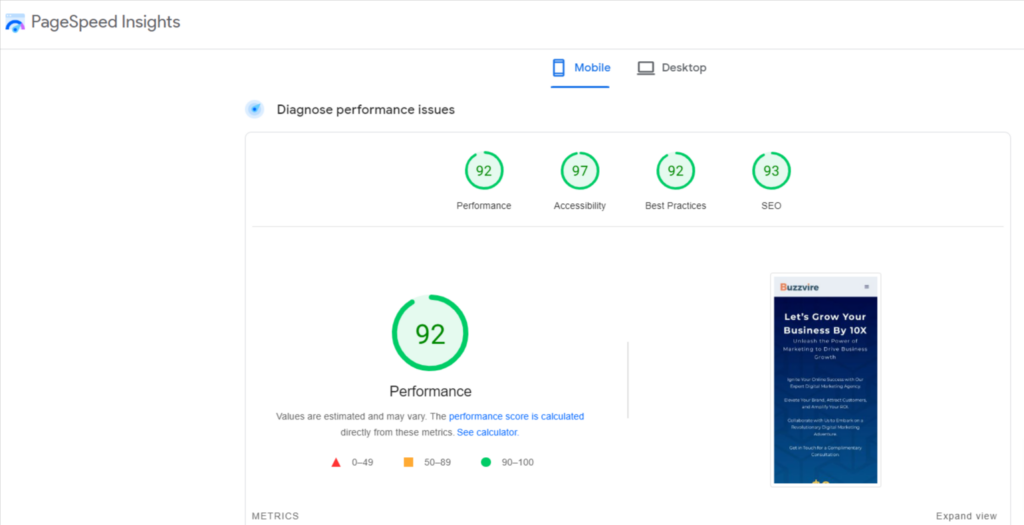
- It doesn’t help if your site is fast but not interesting enough for visitors. Valuable and relevant content connects with your audience. Try to give a suitable solution or direction to your readers’ problem rather than pushing information that is already available in plenty on the Internet.
- When users visit your site, is it easy to read through the various pages and blogs? Use H1, H2, and other heading to organize your content and make it presentable. Make sure the site is mobile-optimized for readability and navigation.
- Build quality backlinks from reputed and relevant websites to improve your SEO likability—the more backlinks, the better your site’s reputation. You can also build effective website authority using guest posting and content promotions.
- Key metrics like traffic, bounce, and conversion rates help track your website’s performance. Keep track of the metrics to identify any areas that require attention. Data reports via analytics tools allow monitoring of the website performance and take action as necessary.

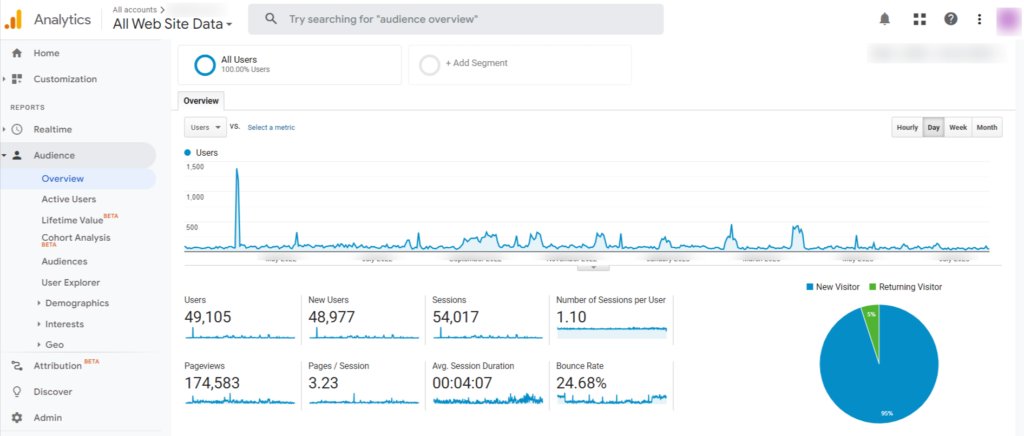
What are the best tools to use for website optimization, and how can they help you achieve your SEO goals?
Undoubtedly, Google Analytics is one of the most useful tools for understanding a website’s performance, the sources your visitors come from, if they click links, filled a form, and the pages they’ve navigated. Google Search Console is a tool to analyze your website in search results and present suggestions to improve your site. Moz and SEMrush are useful if you’re looking for a detailed keyword analysis to better your search rankings. These tools give you insights into what people are searching for and how you can optimize content to reach more potential customers.
Why building high-quality links is essential for improving your website’s ranking in search results?
High-quality links add credibility to your website and assure the search engines and visitors that your website is trustable. Higher backlinks improve your SEO score, pushing your ranking higher. With backlinks, new relevant visitors come to your site, increasing your chances of gaining new followers and possibly customers too.
A step-by-step guide to building quality links, including guest posting, broken link building, and other effective tactics
- Broken Link Building: Find all broken internal, external links or backlinks with the available tools. You may need to contact website owners or managers to have the links fixed.
- Guest Posting: This method is part of gaining backlinks to your website. Submit high-value blogs to relevant websites that match your niche. You may receive a backlink, and it could be a free or paid service. Interested audiences may visit your website, giving you a return on your investment.
- Collaborate with Influencers: It’s a great idea to collaborate with influencers whose domain is similar to yours and promote content to their followers. This may or may not involve a fee. They could help you reach a wide range of followers, and in a short time, you could gain credibility and followers too.
- Social Media Promotion: Another popular way of sharing content is through social media platforms. Organically building an audience that shares with you takes a while. Your content must be relevant and relatable to your audience.
- Directory Submissions: Various websites and listings promote your content to interested readers with or without a fee. People who search for relevant content will read your content and click the link in the directory to reach your website.

Track and Measure Your Results
Why tracking and measuring your results is crucial for monitoring your website’s progress?
It’s important to keep track of your progress on SEO efforts. This aids in knowing if anything needs fixing and making informed decisions for improvement. Measure and track your traffic sources and change your approach to boost that ensures growth and success. With reports of your SEO efforts, you can tell how many people take action and whether your website is favorable from the traffic source.
How to measure and track your SEO results, including the best metrics to focus on?
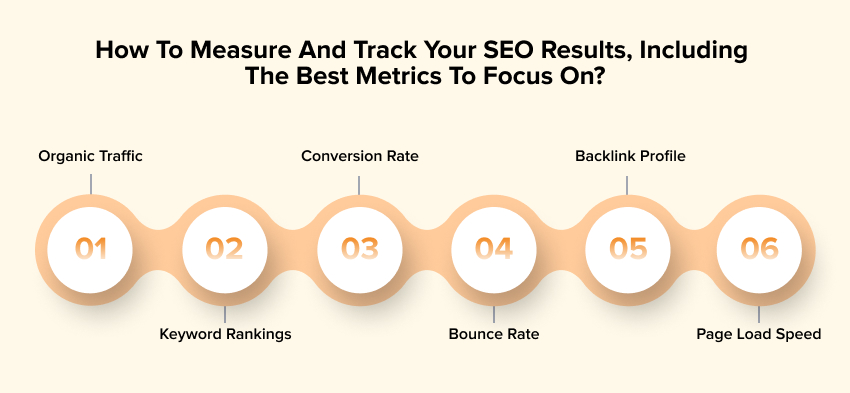
- Organic Traffic: This tells you the number of people that visit your website and from which source they arrive. It helps you fine-tune your efforts towards driving more organic from your desired source.
- Keyword Rankings: This is where you can evaluate the performance of your keywords. The better your keyword performs, the higher your page shows in the SERPs, and the more organic traffic to your site.
- Conversion Rate: An engaging and valuable website encourages visitors to take action. These actions could be filling out details in a form or subscribing to a free or paid service. Conversion rate tells you just how good your website is, making visitors take action.
- Bounce Rate: You want people to spend a lot of time on your website to have a chance to convert them into customers. If many people leave your website soon after entering it, your site has a high bounce rate, and you must fic things to change that.
- Backlink Profile: For search engines, lots of backlinks to a website mean high credibility. So try a reputed website to provide you with a link or two to direct some of the relevant traffic to yours.
- Page Load Speed: Visitors like to have information as quickly as they land on your page. That’s the reason your site must have good page load speed. A higher value means search engines are likely to recommend your site.
Conclusion
If you want to optimize your website for popular search engines like Google, Bing, etc., you must remember that it is a regular activity. This process needs constant monitoring and applying changes to keep it aligned with the SEO goals. It means understanding the target audience’s changing needs and making changes to your content accordingly. Your website’s visibility and the ability to draw organic visits increases with optimizing your website’s structure and content, conducting thorough keyword research, and building good-quality backlinks.
Using tools like Google Analytics and other popular tools makes tracking and monitoring your SEO efforts easier. You will need to dedicate enough time for applying the changes from the tool reports periodically. It takes effort to even keep your ranking your page higher in the SERPs. As market trends and customer preferences change, you may need to update your content and SEO strategy to meet your SEO goals.
FAQs
An effective SEO strategy is a sum of many efforts from directions. The key portion is the research on your target audience. You may need to tweak on-page and off elements to update the content. It’s vital to optimize your website structure as industry standards and most importantly have several good backlinks
Some popular paid and free tools for keywords research are Google Keyword Planner, Moz Keyword Explorer, or SEMrush. These point out the keywords your competitors are ranking for and how you stand against them. You may choose between keywords based on their ranking, relevance and volume, or competition. This is good for starting and you may alter your keywords as needed.
The process of on-page optimization is updating parts of your website so they rank higher for your intended keywords. The process includes updating on the title tags of pages, internal linking and the on-page content. Search engines look for these aspects and if they match the user’s query or intent. Your pages rank higher these are a match.
Backlinks may disappear, go broken or irrelevant so ensure your auditing them regularly. Here are some key link-building strategies:
– Competitor backlink analysis and replicating them
– Update or fix broken backlinks
– Use guest posting regularly
– Invite or tie-ups with industry experts


